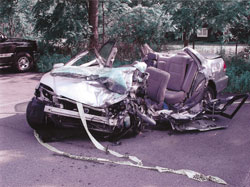By; Anthony Gair,
In personal injury cases predicated upon the negligent design of a product,(product liability cases), such as almost any type of machine which is to be used by people of varying training and skill it is imperative for the plaintiff’s attorney to understand the basics of machine design. This is crucial in New York where the plaintiff’s culpable conduct is a defense to a strict product liability action so that the percentage of fault for his injury may be, if not eliminated, reduced as much as possible. It is not enough for an attorney to simply ask a product design engineer at deposition how the product works. Such questions alone are pointless and will not result in a deposition which can be used to defeat a motion for summary judgment, or at trial, to impeach the product design engineer. As in any deposition the lawyer must ask himself what the purpose of the deposition is. Is it merely to gather information or is it to cross examine the witness so he will be pinned down at trial? In a product liability case in New York the plaintiff is allowed to serve extensive interrogatories. Hence if well drafted the plaintiff’s attorney will have most of the discovery needed for both deposition and trial. Hence it is submitted that the primary purpose of the deposition of a product design engineer is to cross examine him on the principles of design engineering. Similar to a deposition of a physician in a medical malpractice case where the plaintiff’s lawyer must know the medicine as well, if not better, then the physician the plaintiff’s lawyer must know the principles of design engineering as well as the design engineer. If one is not willing to learn this area there is no reason to undertake a complex product design defect case. The plaintiff’s lawyer must check the college and graduate school curriculum for the field of design engineering and read as many of the texts used in design engineering courses as possible.. If a lawyer is not willing to make this commitment he is better off referring the case to a specialist in product design defect cases. The following is a basic discussion of the principles of machine design.
Machine design is a sub-specialty of mechanical engineering. In designing machines, design engineers must take into consideration that a machine, will be used by people of varying intelligence, education and skill. “Human factors engineering, engineering psychology, and ergonomics are largely overlapping segments of a common area of interest: the analysis and design of the conditions affecting people operating in concert with machines”. 1
Ergonomics, or Human Factors Engineering and Design as it is commonly referred to in the United States, involves the consideration by the design engineer of human factors and characteristics when designing safety features into machines. The cardinal principal is that it is human nature to err, that is, people make mistakes. It is standard and accepted practice that the concept of human error be taken into consideration when designing a machine. A machine, must be designed to reduce, as much as is technologically feasible, without destroying the utility of the machine, foreseeable actions by the operator causing injury or death.
In designing a machine a hazard analysis must be done. From a design engineering standpoint a hazard is a condition that has the potential of causing or contributing to injury.
Danger in the context of safety design engineering theory means a higher probability of the risk of an identified hazard causing injury. Risk is the probability of being injured by an identified hazard.
When a design engineer has identified a foreseeable dangerous hazard, there is a safety design priority recognized by all design engineers with reference to preventing injury from the identified hazard which is a follows:
A. Design out the hazard if one can do so without destroying the ability of the machine to function or utility of the machine.
B. If an identified hazard cannot be designed out of the machine without destroying its ability to function or utility the next goal of the design engineer is to guard against it causing injury by incorporating guards or other safety devices.
C. The last alternative is that if one can’t design out the hazard because doing so would destroy the utility of the machine and one can’t guard against it by incorporating guards or safety devices, the last priority is to warn about it. It is the ethical responsibility of the design engineer for the machine to develop a safe functional design which eliminates or greatly reduces the potential for human error on the part of the machine operator causing injury to him self or others.
The following are sample questions that should be asked in a design defect case at the deposition of the design engineer who designed the product;
Continue reading →
 New York Personal Injury Attorneys Blog
New York Personal Injury Attorneys Blog


 In their Trial Advocacy feature,
In their Trial Advocacy feature, 

